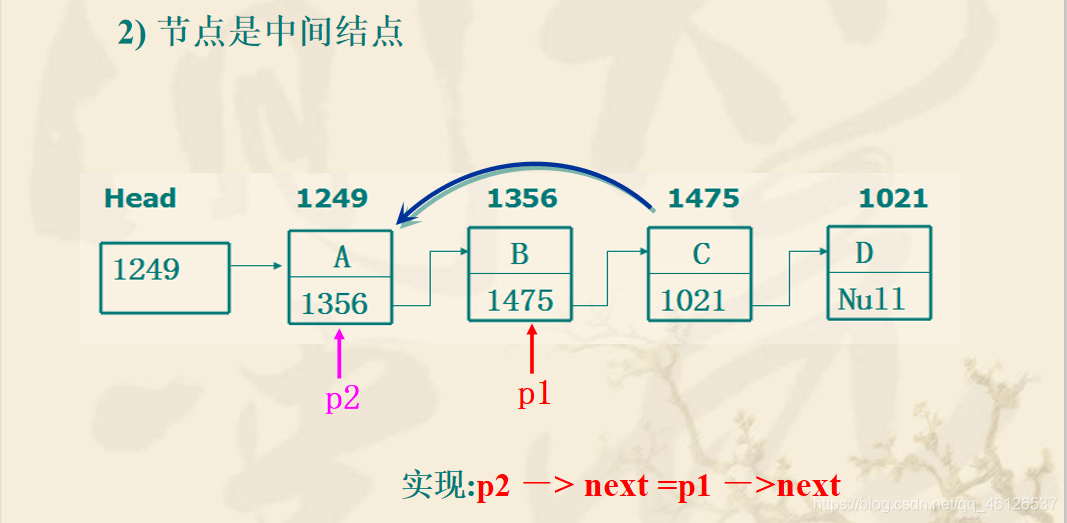有关动态内存分配的函数
1、malloc函数
函数原型为void *malloc(unsigned int size);
作用是在内存的动态存储区中分配一个长度为size的连续空间。此函数的值(即“返回值”)是一个指向分配域起始地址的针(类型为void)。如果此函数未能成功地执行(例如内存空不足),则返回空指针(NULL)。
定义动态数组
double m,n;
double **p'
p=(double *)malloc(sizeof(double *)*m);
for(i=0; i<m; i++)
p[i]=(double *)malloc(sizeof(double)*n);
2、calloc函数
函数原型为void *calloc(unsigned n, unsigned size);
作用是在内存的动态存储区中分配n个长度为size的连续空间。
函数返回一个指向分配域起始地址的指针;如果分配不成功,返回NULL。
用calloc函数可以为一维数组开辟动态存储空间,n为数组元素个数,每个元素长度为size
3、free函数
函数原型为void free(void *p);其作用是释放由p指向的内存区,使这部分内存区能被其他变量使用。
链表的数据结构
用结构体定义链表
struct student
{
int num;
float score;
struct student *next;
}
有头链表和无头链表:
有头:

头指针指向第一个元素的地址
无头:

没有头指针,直接开始存储第一个元素
动态链表的建立和使用:
头插:每次将元素插入链表的头部
尾插:每次将元素插入链表的尾部
无头操作
#include <stdio.h>
#include <stdlib.h>
#include <string.h>
struct node *creat(struct node *head,int n);
void print(struct node *head);
struct node
{
int num;
float sco;
struct node *next;
};
int main()
{
struct node *head;
head=(struct node *)malloc(sizeof(struct node));
if(!head)//容错
exit(0);
int n;
scanf("%d",&n);
head=creat(head,n);
print(head);
return 0;
}
struct node *creat(struct node *head,int n)//尾插法
{
int i;//统计节点的个数
struct node *p1,*p2;
head=NULL;//表示无头
p2=head;//无头就这么写
for(i=0;i<n;i++)
{
p1=(struct node *)malloc(sizeof(struct node));
if(!p1)//容错
exit(0);
scanf("%d%f",&(p1->num),&(p1->sco));
if(head==NULL)//如果链表为空 则连接到第一个节点
{
head=p1;
}
else//如果链表非空 则插入尾部
{
p2->next=p1;
}
p1->next=NULL;//当前节点指向空
p2=p1;//指向当前插入的节点
}
return head;
}
struct node *creat(struct node *head,int n)//头插法
{
int i;//统计节点个数
struct node *p;
head=NULL;//表示无头
for(i=0;i<n;i++)
{
p=(struct node *)malloc(sizeof(struct node));
if(!p)//容错
exit(0);
scanf("%d%f",&(p->num),&(p->sco));
if(head==NULL)
{
p->next=NULL;
}
else
{
p->next=head;
}
head=p;//将头结点 next指向赋给新结点
}
return head;
}
void print(struct node *head)
{
struct node *p;
p=head;
if(head!=NULL)
{
do
{
printf("%d %.2f\n",p->num,p->sco);
p=p->next;
}while(p!=NULL);
}
}
有头操作
#include <stdio.h>
#include <stdlib.h>
#include <string.h>
struct node *creat(struct node *head,int n);
void print(struct node *head);
struct node
{
int num;
float sco;
struct node *next;
};
int main()
{
struct node *head;
head=(struct node *)malloc(sizeof(struct node));
if(!head)//容错
exit(0);
int n;
scanf("%d",&n);
head=creat(head,n);
print(head);
return 0;
}
struct node *creat(struct node *head,int n)//头插法
{
int i;//统计节点个数
struct node *p;
head->next=NULL;//表示有头
for(i=0; i<n; i++)
{
p=(struct node *)malloc(sizeof(struct node));
if(!p)//容错
exit(0);
scanf("%d%f",&(p->num),&(p->sco));
p->next=head->next;//把头结点的next指向新节点
head->next=p;
}
return head;
}
struct node *creat(struct node *head,int n)//尾插法
{
struct node *p1,*p2;
int i;
head->next=NULL;//表示有头
p2=head;
for(i=0;i<n;i++)
{
p1=(struct node *)malloc(sizeof(struct node));
if(!p1)
exit(0);
scanf("%d%f",&(p1->num),&(p1->sco));
p1->next=p2->next;
p2->next=p1;
p2=p1;
}
return head;
}
void print(struct node *head)
{
struct node *p;
p=head->next;
if(head!=NULL)
{
while(p)
{
printf("%d %.2f\n",p->num,p->sco);
p=p->next;
}
}
}
链表中节点的删除



struct student *del(struct student *head,long num)
{
struct student *p1,*p2;
if (head==NULL)
{
printf("\nlist null!\n");
goto end;
}
p1=head;
while(num!=p1->num && p1->next!=NULL)
{
p2=p1;
p1=p1->next;
}
if(num==p1->num)
{
if(p1==head)
head=p1->next;
else
p2->next=p1->next;
printf("delete:%ld\n",num);
n=n-1;
}
else
printf("%ld not been found!\n",num);
end;
return(head);
}
链表中插入节点


struct student *insert(struct student *head, struct student *stud)
{
struct student *p0,*p1,*p2;
p1=head;
p0=stud;
if(head==NULL)
{
head=p0;
p0->next=NULL;
}
else
{
while((p0->num>p1->num) && (p1->next!=NULL))
{
p2=p1;p1=p1->next;
}
if(p0->num<=p1->num)
{
if(head==p1)
head=p0;
else
p2->next=p0;
p0->next=p1;
}
else
{
p1->next=p0;
p0->next=NULL;
}
}
n=n+1;
return(head);
}

#include <stdio.h>
#include <stdlib.h>
#include <string.h>
#include <math.h>
struct node
{
int data;
struct node *next;
};
struct node *creat(struct node *head,int n);
void print(struct node *head);
struct node *insert(struct node *head);
int main()
{
struct node *head;
head=(struct node *)malloc(sizeof(struct node));
if(!head)
exit(0);
head=creat(head,3);
head=insert(head);
print(head);
return 0;
}
struct node *creat(struct node *head,int n)
{
struct node *p1,*p2;
int i;
head->next=NULL;
p2=head;
for(i=0;i<n;i++)
{
p1=(struct node *)malloc(sizeof(struct node));
if(!p1)
exit(0);
scanf("%d",&(p1->data));
p1->next=p2->next;
p2->next=p1;
p2=p1;
}
return head;
}
void print(struct node *head)
{
struct node *p;
p=head->next;
if(head!=NULL)
{
while(p)
{
printf("->%d",p->data);
p=p->next;
}
}
}
struct node *insert(struct node *head)
{
struct node *p1;
p1=head;
int n=2;
while(n--)
p1=p1->next;
//printf("%d",p1->data);
struct node *p2;
p2=p1->next;
struct node *p0;
p0=(struct node *)malloc(sizeof(struct node));
scanf("%d",&(p0->data));
p1->next=p0;
p0->next=p2;
return head;
}